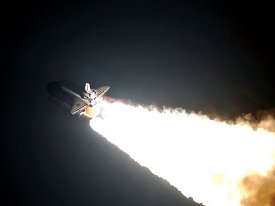Mar 12 2008
A suite of materials developed at the University of North Dakota Energy & Environmental Research Center (EERC) are loaded and ready to lift off on the space shuttle Endeavor on March 11, 2008. The shuttle blasts off at 2:28 EDT.
 Space shuttle Endeavour soars into orbit to start the STS-123 mission to the International Space Station.
Space shuttle Endeavour soars into orbit to start the STS-123 mission to the International Space Station.
The material, made up primarily of silicon carbide, an extremely hard ceramic, will be tested on the International Space Station as part of the Materials International Space Station Experiment 6 (MISSE-6) mission. The goal of MISSE-6 is to characterize the performance of materials and systems exposed to the space environment.
"We've worked in 50 countries and all 50 states and now in an area that doesn't have a zip code," said EERC Director Gerald Groenewold.
The material was originally developed by the EERC for use in the power industry with funding from the U.S. Department of Energy and was delivered to NASA in the fall of 2006.
"While the material has a variety of uses, I see two possible applications in space technology," said EERC Senior Research Advisor John Hurley. "One of those is as spacecraft protection from impact by meteoroids or space debris. The other is as a heat shield."
For meteorite protection, the best shields would be harder than the objects hitting them to ensure that those objects are being vaporized upon impact. Most currently available ceramic materials are prone to shattering, but the EERC materials are porous, which allows them to be combined with other materials, such as metals or polymers, making them shatter-resistant.
When used as heat shield protection, the EERC silicon carbide structures can withstand temperatures of 1450 C or more, which is much higher than other similarly made silicon carbide structures. Because of its makeup, the EERC material actually carries away heat rather than just passively radiating it like the space shuttle tiles. The ability to withstand these higher temperatures is critical during reentry into the earth's atmosphere or in the process of aerobraking, in which the atmosphere of a planet is used to slow down an approaching spacecraft for orbit.
The four EERC samples are 3-inches long by 1-inch wide and were placed, along with other test items, into large cases that are loaded onto Endeavor. The cases will be attached to the International Space Station during a spacewalk scheduled for the eighth day of the mission, which will be the third extravehicular activity. The materials are scheduled for 1 year of exposure and will make approximately 6000 orbits and 150 million miles around the Earth.
"This is a wonderful example of the immeasurable opportunities for spin-offs of EERC-derived technology that have evolved from energy and environmental programs that relate to other key technological frontiers,"Groenewold said.
Posted March 12th,2008